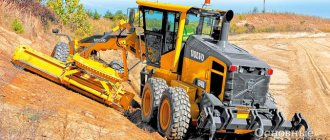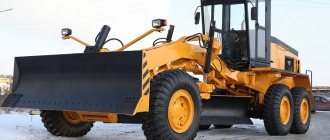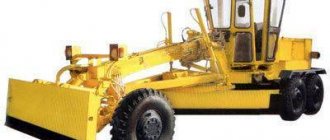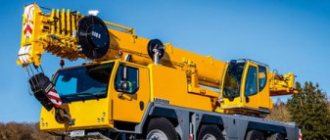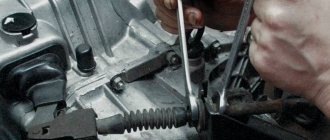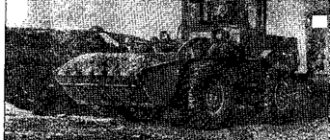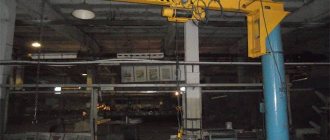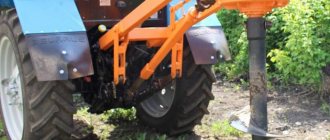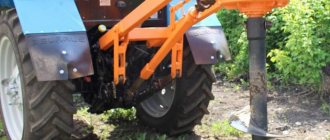Foreign brands
The first motor grader was developed in 1919 by Russell (USA), which used Caterpillar tractors as tractors (before that, similar machines were horse-drawn). In 1928, Caterpillar purchased the Russell, and a few years later a completely redesigned and modernized grader with a 40-horsepower engine appeared, which became the forerunner of the company's modern products. Today's Cat M3 Series can be considered the industry standard, both because of history and the innovation and technology that the company has been implementing over the past 80 years. Electronically adjustable control handles help the operator work tirelessly at their best (levers are a thing of the past), and features like return-to-center articulation make work easier.
More powerful than their predecessors, models 12M3 (weight 19,344 kg, power 179 hp, blade width 3.7 m), 140M3 (weight 19,935 kg, power 200 hp, blade width 3.7 m) , 160M3 (weight 20,660 kg, power 221 hp, blade width 4.2 m) and their all-wheel drive versions are ready to perform any task. Thanks to the high torque, smooth operation is achieved with a sharp short-term increase in load. The hydraulically driven cooling fan speed is automatically adjusted based on engine temperature. The sealed front axle axle is in an oil bath, and the roller bearing is installed on the outside, which increases its service life. Multi-disc service brakes in an oil bath have now become a standard for any serious equipment; the M3 has all the wheels of the rear bogie with their own brakes. Different flow rates for the piston and rod cavities of the hydraulic cylinder are ensured using electro-hydraulic compensating valves, which improves the response of the working equipment.
Simultaneous operation of the working bodies “without losses” and without reducing engine speed is ensured due to the proportional flow rate of hydraulic fluid. Operators will note a comfortable workspace with well-functioning heating and ventilation. Additional LED lights in the engine compartment make the grader easier to maintain in low light conditions. The factory-installed adjustable grade control system automatically controls one side of the blade using grade sensors, ultrasonic and laser sensors, and GPS. Using another built-in system, you can track the location of the machine, the nature of the work and the condition of the equipment in real time.
Volvo family of self-propelled graders includes four models with the D7 engine and three models with the D9 engine. The offered models are characterized by high performance and flexibility in operation. The product line includes five tandem drive self-propelled graders: G930, G940, G960, G970 and G990, as well as G946 and G976 all-wheel drive graders. The cars meet European standards for emissions and noise. Widely spaced blade lift cylinders and a side shift cylinder with low operating angles ensure blade stability. The hydraulic system with proportional flow distribution depending on the load, in combination with an automatically controlled blade, trolling pedal and a circle turning system with two drive gears, allows for increased sensitivity of control of the implement. The number of work steps per pass increases, and high precision movements help reduce costs. At the customer's request, a transmission with an extended speed range can be installed, which will provide high control efficiency in the lower range, optimal travel speed in the upper range, flexibility in the operating range and additional fuel economy. An automatic transmission mode is available.
The design of the machine is designed for long, trouble-free operation. To reduce wear, the turntable bearings are made of high-strength polymer material. The original heavy-duty frame hinge is safe for hydraulic hoses. The key elements of the all-wheel drive system of Volvo motor graders are two variable displacement axial piston pumps that directly drive the wheel motors. The performance of the pumps is adjusted depending on the selected operating mode, which allows you to precisely control the transfer of power to the wheels. The system does not require the installation of a flow divider valve and ensures efficient power transfer from pumps to motors with minimal losses. The display in the grader cabin provides detailed information about the current status of the machine. In addition, the system records and can store 25 operating parameters for subsequent analysis. With all the benefits of a joystick, old-school operators will be able to choose a machine equipped with levers.
John Deere graders' new distinctive high-clearance frame design increases turntable clearance and blade work area and makes it easier to rotate the blade into cutting position. The event-based programming (EBS) transmission measures engine load as well as other inputs for optimal smooth shifting each time the operator selects a new gear. Among the features, we can also note high-strength tapered roller bearings in the articulated joint, as well as self-lubricating bearings in other main components.
The automatic differential lock remains engaged when driving in a straight line, is switched off when cornering in excess of 10°, and is switched on again when returning to the straight line. Automated cross-slope traversing makes it easier to maintain stable slope control by performing the job with just one lever. The operator simply selects the desired slope and side of the blade to be controlled manually. Once installed, the system automatically adjusts the opposite blade lift cylinder to maintain grade. Leveling control buttons are integrated directly into the control levers. The activation of auxiliary functions is carried out using mini-levers, which are located on the right armrest, and large paired levers that control the main mechanisms. You can control the car using one of the levers on the left armrest or a regular steering wheel. Return to straight line automatically straightens the articulated frame at the touch of a button.
From the presented brief overview it is clear that global brands, as they say, “go shoulder to shoulder”, quickly introduce the latest technologies, trying to present to the market not just a grader, but a machine with outstanding capabilities. Chinese products in the grader segment are also quite widely represented. Up to half of imported cars today arrive on the Russian market from the Middle Kingdom. The bulk of our cars are sold under the XCMG brand. This is not surprising, since graders from Xuzhou and in their homeland are the undisputed market leaders. Of course, the level of Chinese manufacturers is still far from that of companies in developed countries, nevertheless, this equipment finds its consumer in Russia.
The light grader GR135, medium-class models GR165, GR180 and GR215 with hydromechanical transmission are equipped with Chinese-made Cummins engines, Xuzhou-Meritor axles (PRC-USA) and Chinese gearboxes. Like all Chinese special equipment, these are fairly simple machines with lever control and without any electronics. The only all-wheel drive model is the GR215A, which is also already well known in Russia. Other manufacturers from China produce similar models that differ little in configuration. Among the most famous in our country are Liugong and Tiangong.
This is interesting: OKVED for rental services of special equipment
Device
The motor grader DZ-143 consists of the following main parts: A long and curved in the middle part of the main frame 1, which serves to install all the mechanisms of the motor grader on it and rests on the rear trolley 10, equipped with balancers with drive wheels 8, and in front on the front axle 4 with steerable wheels; engine 14, mounted on top of the frame above the rear bogie; transmission that transmits rotation from the engine to the drive wheels, hydraulic pumps, etc.; grader blade 7, located in the space under a curved narrow part of the frame, called the center beam, on a special traction frame 6, secured with a spherical hinge on the end part of the center beam above the front axle and two hydraulic cylinders for lifting the blade 2, mounted on brackets from two the sides of the spinal beam in its most elevated part; cabins 11 with organs and control panel and driver's seat; bulldozer blade 5, hydraulic cylinder 12 for their drive; hood 9 with hinged walls covering the engine; electrical alarm and lighting systems13.
Studying the operating manual for the DZ-143 grader, you can note that the main working compartments of the machine are a full-fledged hydraulic system. The frame design is rigid, which makes it possible to perform complex technological operations, in particular, to lift a sufficient volume of soil material.
dimensions
Main dimensions:
- Length – 8950 mm;
- Width – 2500 mm;
- Height – 3510 mm (lighthouse is not taken into account);
- The length of the grader blade is 3740 mm;
- The height of the grader blade is 620 mm;
- Lateral extension – 800 mm;
- Drop below the supporting surface – 250 mm.
As for the bulldozer blade, its height is 840 mm. The loosening width reaches 1300 mm, the depth – up to 250 mm. According to the standard scheme, the ripper is equipped with three teeth. Tire sizes range from 14 to 20 inches.
Cabin
The operator's cabin is quite spacious, which allows the specialist in some cases to perform actions while carrying out road work while standing, without using a seat. All machine controls are within walking distance. There are disadvantages, such as the lack of a proper air conditioning system, which creates problems when operating graders in hot areas. The operator had to constantly keep the door open, creating air circulation. Dust and dirt that came from outside created problems in the operation of grader equipment.
The visible view from the operator's cabin is quite voluminous and spacious, which gives reason to talk about a convenient option for carrying out technological operations. The grader is currently out of production, but spare parts are produced by related suppliers, so there is no problem in purchasing spare parts for the popular Soviet-era grader.
Equipment
At the front of the machine there is a blade and a leveling knife - these are the main elements of the grader.
Grader DZ 143 and its operating manual provide for the possibility of equipping the machine with additional working parts:
- A pickaxe with teeth. Thanks to this device, you can loosen hard soils and open worn-out surfaces during repairs: asphalt concrete and crushed stone.
- Sweeping brush. This equipment configuration is very effective in the summer. It allows you to effectively work on road maintenance: removing soil deposits from the edge of the pavement and removing debris from the roadway.
- Road plow. This device is used to organize passages in areas with deep snow. It is popular when carrying out work to remove large amounts of snow on roads and airfields.
- Side snow blower. This item is a traditional blade that is mounted to the right side of the grader and ensures that snow is thrown beyond the boundaries of the cleared area.
- Ice cutter. With the help of this body, ice and masses of compacted snow are removed from the roadway. It is worth noting that when carrying out work in winter, the machine is additionally equipped with snow chains, which are installed on the rear wheels of the machine
Classification of motor graders
By wheel type:
- On metal wheels. Such models will cost less, they are simpler and do not require expensive maintenance. A significant disadvantage of such graders is their low speed - 5-6 km/h.
- On pneumatic wheels. This type of grader is more expensive, and maintenance is somewhat more difficult, but they are more powerful and can move under their own power at speeds of up to 30 km/h.
By weight and power of the motor grader:
- Lungs. The mass of such machines is 9-12 tons, and the power is 75-90 horsepower. They are used primarily for planning, marking, and patrolling;
- Average. Weight 13-15 tons, power 120-150 hp. Such models are used mainly for reconstruction, road profiling, as well as mixing materials on site;
- Heavy. The weight of motor graders of this type is 19-20 tons, the power is 250-300 hp. The main scope of application is the construction of asphalt and earthen roads.
By transmission type:
- With manual transmission. This type of transmission provides for stepwise and manual changes in the speed of the vehicle;
- With hydromechanical transmission. Automatic and smooth regulation of vehicle speed.
By type of final drives:
- Final drive (for light and medium type motor graders);
- Separate drive axles (heavy vehicles are equipped with them).
Based on the type of frame, motor graders are divided into:
- Models with a rigid frame are more durable, but less maneuverable;
- Models with an articulated frame - such machines are more maneuverable and can perform a wide range of work.
TOP 10 leading imported brands to Russia in January-December 2022
| № | Brand | Model | Share |
| 1 | S.E.M. | 922 | 16,43% |
| 2 | SDLG | G9220 | 9,07% |
| 3 | SDLG | G9190 | 9,07% |
| 4 | CAT | 140M | 7,08% |
| 5 | XCMG | GR165 | 6,52% |
| 6 | SDLG | G9165 | 6,23% |
| 7 | Komatsu | GD825A-2 | 5,67% |
| 8 | LiuGong | CLG4215 | 4,25% |
| 9 | HBM-Nobas | BG240TA-4 | 3,68% |
| 10 | LiuGong | CLG4140 | 3,68% |
| 11 | Others | 28,33% |
Source: ID-Marketing according to the Federal Customs Service
If you find an error, please select a piece of text and press Ctrl+Enter.
Grader (motor grader), types, types, classes, its working equipment, application and characteristics.
Grader is a trailed or self-propelled wheeled machine with an adjustable blade located between the front and rear wheels that cuts, moves and distributes material, usually for grading purposes.
Grader (motor grader)
Working and auxiliary equipment of the grader (motor grader)
Types, types and classes of graders (motor graders)
Grader (motor grader) parameters
Application of a grader (motor grader)
Other road construction equipment: asphalt paver, bulldozer, grader, scraper
Leading motor grader manufacturers
Volvo Construction Equipment. Price – from 3 million rubles. The history of this company began in 1997, when Volvo Construction Equipment acquired the Canadian company Champion Road Machinery Ltd., which had been producing motor graders for many years. In 2000, a new generation of graders came out under the name Volvo. Now there are 2 series: compact graders and medium (heavy) machines of the B series. Compact models are equipped with 4-liter Cummins diesel engines and hydrostatic transmission. Speed range - from 0 to 32 km/h, frame - articulated. Heavy models are equipped with 6-cylinder diesel engines with a volume of 7.1-9.6 liters with turbocharging, electronic injection and intercooling. Automatic transmission, hydrostatic transmission, wide range of additional equipment.
photo: Volvo motor grader
Caterpillar Inc. The cost of equipment is from 380 thousand euros. This company is a fairly well-known manufacturer of specialized equipment. Motor graders are simple, productive and easy to maintain. The lineup includes 9 models of varying power and performance. Most models are equipped with 8-speed electronically controlled gearboxes, powerful engines, hydrostatic transmission, and an extended wheelbase has made the model more productive. In travel mode, motor graders can reach speeds of up to 40 km/h. The basic package can be supplemented with a variety of additional equipment.
photo: Motor grader Caterpillar Inc.
CNH (Case—New Holland). This corporation has three model ranges of motor graders; they are produced under the brands Case, O&K, FIAT-Kobelco. Graders are medium and heavy, as well as one light one with all-wheel drive. The configuration depends on the model range: Cummins diesel, with a volume of 5.9 to 7.5 liters; for heavy models, 8.3 liter engines with a power of 155 kW, equipped with turbocharging, are provided. The transmission has 8 forward gears and four reverse gears, the frame breaks at an angle of 25-28 degrees. Additional equipment includes rippers, counterweights, blade extensions and other elements.
photo: CNH motor grader (Case-New Holland)
Komatsu. Prices start from 2.5 million rubles and above. The Japanese manufacturer presents 2 model ranges of motor graders on the market under the Galion and Komatsu brands. Most cars are equipped with 6-cylinder Komatsu turbocharged diesel engines, their power varies from 104 to 210 kW; for the heavy model they install a Cummis engine with a power of 168 kW and a volume of 10.8 liters. Hydromechanical gearbox, overload protection, precise movement pedal, a reversible gearbox has been specially created for heavy models. The maximum forward speed is 45 km/h, reverse – 47.9 km/h. Galion are medium motor graders, their engine power is 107-152 kW. Additionally, there is a wide choice of configurations.
photo: Komatsu motor grader
American and Japanese manufacturers are significantly ahead of domestic ones, but they are also much more expensive. Chinese analogues are also appearing on our markets, the most famous being XCMG, LongGong CDM, Changlin, Shantui Construction Machinery and others. In terms of cost, they are comparable to motor graders produced at the Chelyabinsk Road Construction Machinery Plant or the Bryansk Arsenal, but they are superior in functionality to Russian equipment.
The choice of motor graders is really large; you need to focus not only on the brand’s popularity, but also on the characteristics presented, the proximity of service centers, the ability to buy spare parts and other practical nuances. We hope our article will make your task a little easier!
On our website you can find advertisements for the sale and rental of motor graders in the Buy a motor grader and Rent a motor grader sections, respectively.
This page has been viewed 14538 times, published on 11/17/2014
Specifications
The GS 14.02 motor grader is a modern 140 class machine, the design of which uses domestic and imported components. Large components and assemblies are created in accordance with user requirements for the technical performance of construction machines. The grader is equipped with various power units and offers owners advanced capabilities.
- Class - 140;
- Operating weight, kg - 13,500;
- Engines D442 / D260 / YaMZ-236 / Cummins 6VT5.9-S135 / Cummins 6VTA-S165;
- Transmission - mechanical;
- Travel speed GS-14.02, km/h: 4.1-34.2;
- Number of motor grader gears: forward - 6; back – 2;
- The wheel formula of the motor grader is 1x2x3;
- Overall dimensions GS-14.02, mm 8820x2500x3475;
- Tires: 14.00-20.00;
- Grader blade: Overall dimensions, mm - 3740x620x250;
- Removal, mm - 800;
- Slope cleaning angle, degrees - 90.
Engine
The manufacturer offers customers a choice of five trim levels. Initially, the car was equipped with a domestic D-442 engine. This is a turbocharged diesel with a rated power of 100 hp. Later, models with power units D-260 and YaMZ-236 with rated power of 100 and 110 hp became available. respectively.
The most modern machines are equipped with imported engines from the American brand Cummins. The Cummins 6ВТ5.9-С135 model produces a maximum power of 100 hp. The Cummins 6VTA-C165 model operates at a maximum power of 120 hp. American engines are reliable and do not require serious repairs over a long period of time. On the other hand, Russian power units are cheaper to maintain, and spare parts for the GS 14.02 motor grader motors are available in any region.
Fuel consumption
This model of the device is equipped with a large fuel tank of 490 liters. Various motor grader configurations use their own engines, so fuel consumption depends on their power. Most often, engines with a consumption of 220 -230 g/kWh are used for these purposes.
Transmission
Modern GS 14.02 graders are equipped with automatic gearboxes of the German ZF brand. As standard with the domestic power unit, the car comes with a manual transmission. GS 14.02 can move with six forward and two reverse speeds. In this case, the speed range is 4.1-34.2 km/h.
The manufacturer used a 1x2x3 wheel arrangement in the grader's chassis. Base models are equipped with 14.00-20 tires. The gearbox is complemented by a NAF tandem bogie and a No-Spin differential. The service braking system is represented by disc brakes controlled by a pedal. The device uses a dual-circuit brake system that provides equal force on all wheels of the motor grader. To increase reliability, the brake mechanism is equipped with a backup power source.
Hydraulic system
The GS 14.02 hydraulic system uses a constant volume pump with an additional system for unloading the working unit when the control handle is in the neutral position. The functioning of the system is ensured by six manual hydraulic valves, with the help of which the working bodies are controlled. Four electric hydraulic valves are used to perform related operations.
Working equipment and blade characteristics
The GS 14.02 motor grader is equipped with a full-rotating grader blade with the following characteristics:
- length - 3740 mm;
- height - 620 mm;
- lowering below the supporting surface - 250 mm;
- offset - 800 mm;
- slope cleaning angle is 90 degrees.
The manufacturer supplies the following as replacement working equipment:
- side grader blade;
- rotary bulldozer blade;
- rear ripper.
Working and auxiliary equipment of the grader (motor grader):
The main components of the grader are the basic wheeled transport vehicle and the main working equipment - a blade , as well as auxiliary (additional) working equipment - a pick, ripper, snow plow, front blade, bulldozer blade, swept blade, slopes, extensions, etc.
The blade is the main working part of the grader, which distinguishes it from other types of road construction equipment. The blade is a rectangular sheet with some radius bend. The blade can be positioned at different angles in the horizontal and vertical planes relative to the longitudinal axis of the base transport vehicle, and can also be carried out and pulled to the side. It can rise, fall and rotate in horizontal and vertical planes.
Blades of all types of graders are equipped with mechanisms with a hydraulic or mechanical drive for raising and lowering the blade, turning in two planes, distortions in the transverse plane, and tilting back and forth along the way. The blade is attached to the traction machine with a rotating mechanism and a traction frame.
Knives are attached along the bottom and side edges of the blade, respectively called the bottom knife and side knife.
Picker - auxiliary equipment in the form of a frame with removable teeth (7-11 teeth) for loosening the soil, destroying road pavements and coatings during road repairs. The pickaxe can be installed in front of the front wheels of the motor grader or between the front and rear wheels.
Ripper is an additional equipment consisting of a frame connected by means of mounting brackets to the rear of the base machine, and equipped with one or more teeth. Ripping equipment is installed not only on motor graders, but in many cases also on bulldozers and tractors.
Snow plow - a structure located in front of the front wheels and designed to move snow in the transverse direction due to the plowing action of the blade. The plow can be single-bladed or double-bladed.
Front Blade - A blade, usually with a curved surface, located in front of the front wheels and designed to rake and push material, usually in a forward direction.
Motor graders are also equipped with automatic leveling systems in order to speed up work operations and obtain surfaces with strictly defined parameters.
Motor graders can be equipped with a remote control system.
This is interesting: Preparing an excavator for work - operating instructions
Device
A machine of this class is used for road surface planning and profiling. Additionally, it is used to create embankments from gravel, various types of soil and crushed stone by leveling and moving them. In winter, it is allowed to use the GS-14.02 motor grader to clear road transport routes from precipitation and formed ice. This is possible due to the wide range of operating temperatures and adaptation to work in tropical and temperate latitudes.
A wide grip on the grader blade is achieved through the use of an articulated frame and rotary grader and bulldozer blades. This design also allows the machine to be used for profiling in the opposite direction of movement due to the reverse gear. The blade is located directly between the front and rear axles and is fully rotatable.
The design feature of the GS-14.02 motor grader is that it is equipped with removable equipment. Therefore, its bulldozer blade can be replaced with a ripper-pick, and it, in turn, can be replaced with a ripper-scarifier. The power of the equipment directly depends on the engine used, but due to the fact that there are several design options, each modification should be considered separately, based on the technical characteristics.
The GS-14.02 motor grader is adapted for work in high mountain areas. This is largely possible thanks to the transmission used. It's made in Germany here. The brake system is dual-circuit hydraulic with a backup power source. It is complemented by a parking brake with gear lock. The hydraulics are supplied with a constant volume pump. It includes 6 hydraulic boosters for the main equipment and four electrical modules for additional equipment, as well as hydraulic locks for the circuits.
The operator's work is facilitated by the automatic blade control system. For this purpose, the design provides a number of sensors and balancers, also containing sensors.
- length - 8820 mm;
- width - 2500 mm;
- cabin roof height - 3475 mm;
- operating weight - 13,500 kg.
Controls
The steering operates on the front pair of swivel wheels through a drive consisting of two hydraulic cylinders. There is no mechanical connection between the wheels and the steering column.
Shoe brakes with hydraulic drive are installed on the wheels of the rear axle. The disc-type parking brake acts on the drive gear shaft of the central gearbox. Cab mounting dampers, heating and ventilation devices, and spring seat suspension create comfortable conditions for the operator.
The cabin equipment is well thought out, and the interior ergonomics are modern. Glazing with a minimum of closed areas, headlights and mirrors provide visibility of the working area and visual control of the motor grader components.
The cabin, reinforced with steel inserts, protects the operator in emergency situations. The turntable for mounting the grader blade is secured in three places by clamping devices. It is controlled by a pair of hydraulic cylinders with valves configured to relieve shock loads.
Prospects for the development of graders
In recent years, the following trends have emerged in the development of motor grader design:
- increasing engine power without significantly increasing the weight of motor graders;
- introduction of hydromechanical transmissions for the chassis of the vehicle: the use of engines adapted to operate at significant rolls, as well as in conditions of low and high temperatures and high dust levels in the air;
- increasing the transport speed of graders;
- automation of control in order to ensure automatic profiling along a given profile - leveling system;
- significant improvement in driver working conditions;
- use of low-pressure tires with centralized regulation of air pressure supplied from the engine compressor.
Return to list of articlesNext article
Articulated frame.
Almost all new motor grader models have an articulated frame (with the possible exception of the smallest ones).
Maintenance of motor graders becomes simpler and more convenient: maintenance intervals are extended, grease injection points, fluid filler necks are extended, and filters are located in groups and can be serviced from ground level. The diagnostic capabilities of electronic control systems are being improved.
New systems have appeared for automatically adjusting the position of the traction frame, turntable and blade. In some cases, thanks to such systems, it was possible to eliminate the turntable adjustment pads from the design. In other cases, they have simplified the design so that replacing wear pads takes only a couple of hours. For motor graders equipped with automatic blade adjustment systems, keeping the blade attachments properly adjusted becomes especially important.
